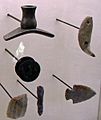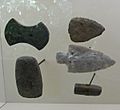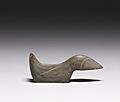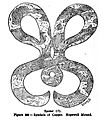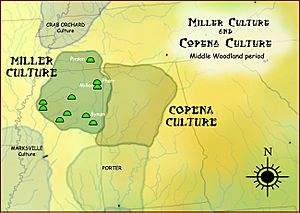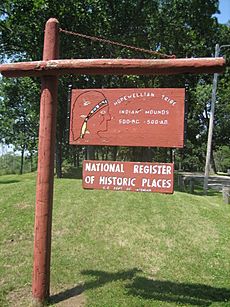Hopewell tradition facts for kids

Hopewell Interaction Area and local expressions of the Hopewell tradition
|
|
| Geographical range | Midwestern United States |
|---|---|
| Period | Middle Woodland period |
| Dates | 100 BCE to 500 CE |
| Type site | Hopewell Mound Group |
| Major sites | Newark Earthworks |
| Preceded by | Adena culture |
| Followed by | Fort Ancient, Mississippian culture |
| Defined by | Warren K. Moorehead |
The Hopewell tradition (also known as the Hopewell culture) refers to a group of ancient Native American societies. These groups lived along rivers in the eastern and midwestern parts of North America. They thrived from about 100 BCE to 500 CE, during a time called the Middle Woodland period.
The Hopewell tradition was not one single group or society. Instead, it was many different groups of people. They were connected by a large trading system called the Hopewell exchange system. This system helped them share ideas and goods across a huge area.
At its biggest, the Hopewell exchange system reached from Lake Ontario in the north all the way to Florida in the south. People in this area traded many things, especially along rivers, which were like ancient highways. They traded special materials from all over what is now the United States. These materials were often turned into new products. Then, these products were traded even further. Many of these traded items have been found in ancient burial sites far from the Midwest.
Contents
How the Hopewell Culture Began
Historians are still discussing exactly how the Hopewell culture started. Some believe the Hopewell people came from western New York. They then moved south into Ohio, where they built on the traditions of the local Adena culture. Others think the Hopewell culture began in western Illinois. From there, it spread to southern Ohio.
The name "Hopewell" was given by Warren K. Moorehead. He explored the Hopewell Mound Group in Ohio in the 1890s. The mound group was named after Mordecai Hopewell, who owned the land. We don't know what these ancient people called themselves. The term "Hopewell" describes many different groups. These groups lived in small, temporary settlements near rivers. They hunted, gathered food, and grew some crops.
Hopewell Society and Leaders
The Hopewell people learned from the Adena culture before them. They started to have different social classes. This helped their societies become more stable. It also encouraged them to settle in one place and grow their populations.
The Hopewell people usually cremated their dead. But they buried their most important people. In some places, hunters seemed to have a higher rank in the community. Their graves were more detailed and had more valuable items.
The Hopewell societies had leaders. However, these leaders did not have total power like kings. They couldn't command armies of slaves. Instead, certain families likely had special importance. Some experts think these leaders were like "big-men". They gained power by convincing others to agree with them. This was important for trade and religious matters. They also built strong relationships with other important community members. These "big-men" were an early step toward more organized societies called chiefdom.
The Hopewell settlements were connected by a huge network of trade routes. These routes also helped people communicate. They brought different groups together for important ceremonies.
Amazing Earthwork Mounds
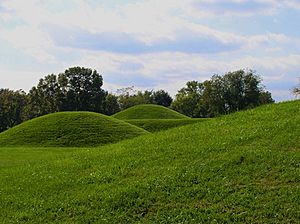
Today, the most impressive things left by the Hopewell tradition are their earthwork mounds. Researchers are still trying to understand why they built them. These huge geometric earthworks are some of the most amazing ancient monuments in North America. They were built by cultures that followed the Hopewell.
Mounds in the Eastern Woodlands often have different geometric shapes. Some are very tall. Some giant earthworks, called effigy mounds, were shaped like animals, birds, or snakes. We have learned a lot about these mounds because many are still in good condition.
Scientists like Dr. Bradley T. Lepper believe the Octagon earthwork in Newark, Ohio, was a lunar observatory. He thinks it was built to line up with the moon's movements over 18.6 years. The Octagon covers more than 50 acres, which is like 100 football fields. Other researchers have also found that the Newark Earthworks and other sites like High Banks Works line up with the moon and sun.
Christopher Turner found that the Fairground Circle in Newark lines up with the sunrise on May 4th. This marks a special cross-quarter day. In 1983, Turner showed that the Hopeton earthworks also line up with sunrises and moonrises. These include the winter and summer solstices, the equinoxes, and other important lunar events. This shows how precise their building skills were.
Many mounds also contain human burials. Valuable items have been found in these graves. These include ornaments made of copper, mica, and obsidian. These materials came from hundreds of miles away. They also made intricate shapes from stone and ceramics.
Beautiful Hopewell Art
The Hopewell people created some of the most beautiful crafts and art in the Americas. Most of their artwork had religious meaning. Their graves were filled with necklaces, detailed carvings from bone or wood, and decorated ceremonial pottery. They also made ear plugs and pendants. Some graves were lined with woven mats, mica (a shiny mineral), or stones.
The Hopewell made art with more variety and exotic materials than the Adena people before them. They used grizzly bear teeth, freshwater pearls, sea shells, shark teeth, copper, and even small amounts of silver. Hopewell artists were skilled at carving pipestone. Many burial mounds contain beautifully carved statues and pipes.
At the Mound of Pipes in Mound City, over 200 stone smoking pipes were found. These pipes showed animals and birds in amazing detail. More than 130 similar items were found at the Tremper site in Ohio. Some art was even made from carved human bones. A rare mask found at Mound City was made using a human skull as a face plate.
Hopewell artists created both realistic and abstract human figures. One pipe is so accurate that researchers identified the person it showed as someone with dwarfism. Many other figures show great detail in clothing, jewelry, and hairstyles. An example of abstract human art is the "Mica Hand" from the Hopewell Site. This delicate hand shape was cut from a piece of mica. It was over 11 inches long and 6 inches wide. It was likely worn or carried for people to see. They also made beaded items.
-
Carved mica hand, Hopewell Mounds
-
Hopewell pipe, points, and earspool on display at Serpent Mound
-
Gorgets and points from the Adena culture, found at Serpent Mound
-
Raven effigy pipe, Mound City
-
Bird figure, Tremper Mounds
-
Repoussé copper falcon at American Museum of Natural History
Different Hopewell Groups
Besides the well-known Ohio Hopewell, many other Middle Woodland period cultures were part of the Hopewell tradition. They also joined the Hopewell exchange network.
Armstrong Culture
The Armstrong culture was a Hopewell group in Kentucky and West Virginia. They lived there from 1 to 500 CE. They might have been a local version of the Hopewell tradition. Or, they might have been a Hopewell-influenced group that mixed peacefully with the local Adena culture people.
Copena Culture
The Copena culture was a Hopewellian group in northern Alabama, Mississippi, and Tennessee. They also lived in nearby areas like Kentucky. The name "Copena" comes from "copper" and "galena." This is because copper and galena artifacts are often found with Copena burials.
Crab Orchard Culture
During the Middle Woodland period, the Crab Orchard culture grew. They went from small, spread-out groups to larger camps. These camps were mostly on river terraces and floodplains. They were found along the Ohio River in southern Indiana, southern Illinois, and western Kentucky.
Goodall Focus Culture
The Goodall focus culture lived in Michigan and northern Indiana. They were there from about 200 BCE to 500 CE. This culture spread from the southern tip of Lake Michigan east to Ohio. It also went north into central Michigan. The culture is named after the Goodall site in northwest Indiana.
Havana Hopewell Culture
The Havana Hopewell culture lived in the Illinois and Mississippi river valleys. This included parts of Iowa, Illinois, and Missouri. They are thought to be ancestors of the groups who later formed the Mississippian culture. This culture built the large city of Cahokia.
The Toolesboro site has seven burial mounds. They are on a bluff overlooking the Iowa River. These mounds were built between 100 BCE and 200 CE. Mound 2 is the largest remaining mound. It is 100 feet wide and 8 feet tall. It might have been the largest Hopewell mound in Iowa.
Kansas City Hopewell
The Kansas City Hopewell lived at the western edge of the Hopewell trade network. The Renner Village site in Riverside, Missouri, is one of several sites near the Missouri River. It has remains from both Hopewell and later Mississippian cultures. The Trowbridge site near Kansas City is also near the western edge of Hopewell influence. Pottery and stone tools typical of the Hopewell are common there.
Laurel Complex
The Laurel complex was a Native American culture in parts of Canada and the United States. This included southern Quebec, Ontario, and Manitoba in Canada. It also included northern Michigan, Wisconsin, and Minnesota in the US. They were the first people in Ontario north of the Trent–Severn Waterway to use pottery.
Marksville Culture
The Marksville culture was a Hopewellian group in the Lower Mississippi Valley. This included parts of Louisiana, Mississippi, Missouri, and Arkansas. This culture later developed into the Baytown culture and then the Coles Creek and Plum Bayou cultures. It is named after the Marksville Prehistoric Indian Site in Marksville, Louisiana.
Miller Culture
The Miller culture was a Hopewellian group in parts of Tennessee, Mississippi, and Alabama. They are known from sites like Pinson Mounds, Bynum Mounds, and Pharr Mounds. Some Miller culture sites built large platform mounds. Archaeologists think these mounds were used for feasting rituals. This was different from later Mississippian platform mounds, which were for burials or buildings. By about 1000 CE, the Miller culture area became part of the Mississippian culture.
Montane Hopewell
The Montane Hopewell lived in the Tygart Valley area of northern West Virginia. Their pottery and culture were similar to the late Ohio Hopewell. They built small, cone-shaped mounds in the late Hopewell period. This suggests that the religious practices of the Hopewell might have been less important in their daily lives here.
Ohio Hopewell Culture
| Preceded by Adena culture |
Ohio Hopewell 200 BCE-500 CE |
Succeeded by Fort Ancient |
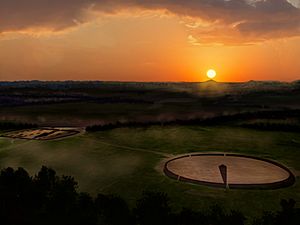
The most Hopewell ceremonial sites are in the Scioto River Valley in Ohio. This area is centered around Chillicothe, Ohio. These sites usually had a burial mound and a large geometric earthwork complex. These complexes covered many acres. There is little evidence that many people lived at these monument sites.
The Hopewell Culture National Historical Park is near Chillicothe, Ohio. It includes the mounds that gave the culture its name. Other earthworks in the Chillicothe area include Hopeton, Mound City, and Newark Earthworks. When early European settlers arrived, they were amazed by these huge structures. Some were as tall as 70 feet and covered many acres.
The Portsmouth Earthworks were built from 100 BCE to 500 CE. This was a large ceremonial center where the Scioto and Ohio rivers meet. Part of this earthwork complex even crossed the Ohio River into Kentucky. It included circular enclosures, horseshoe-shaped enclosures, and parallel-walled roads.
Point Peninsula Complex
The Point Peninsula complex was a Native American culture in Ontario, Canada, and New York, United States. They lived there during the Middle Woodland period. They were likely influenced by the Hopewell traditions from the Ohio River valley. This influence seemed to stop around 250 CE. After that, they no longer practiced burial ceremonies.
Saugeen Complex
The Saugeen complex was a Native American culture around Lake Huron and the Bruce Peninsula in Canada. Some evidence suggests that the Saugeen complex people might have become the historic Odawa people.
Swift Creek Culture
The Swift Creek culture was an archaeological culture in the southeastern United States. This included parts of Georgia, Alabama, Florida, South Carolina, and Tennessee. They lived there from about 100 to 700 CE.
Wilhelm Culture
The Wilhelm culture (1 to 500 CE) was influenced by the Hopewell. They lived in the northern panhandle of West Virginia. Their pottery was similar to Armstrong pottery, but not as well made. They built small, cone-shaped mounds over individual burials. These burials were in stone-lined graves.
Why the Hopewell Culture Declined
Around 500 CE, the Hopewell exchange system stopped. People also stopped building mounds and making their special art. There are several ideas about why this happened.
One idea is that there was more warfare. Villages from the later Woodland period became larger. They built defensive walls and ditches. Colder weather might have also caused animals to move away. This would have made it harder to find food. The invention of the bow and arrow made hunting easier. This might have put stress on animal populations. This could have also led people to live in larger, safer communities.
With fewer people using the trade routes, the network connecting Hopewell traditions broke down. The way society was organized might have also changed because people started farming more. The exact reasons for the Hopewell people's dispersal are still unknown.
| Preceded by Early Woodland period Adena culture |
Hopewell tradition 200 BCE – 500 CE |
Succeeded by Late Woodland |
See also
 In Spanish: Cultura Hopewell para niños
In Spanish: Cultura Hopewell para niños




